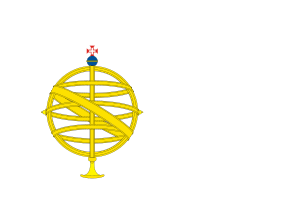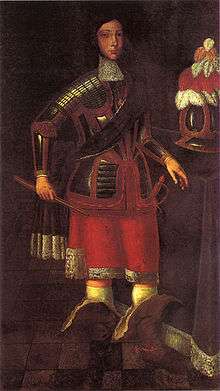Prince of Brazil
.png)

Prince of Brazil (Portuguese: Príncipe do Brasil) was the title held by the heir-apparent to the Kingdom of Portugal, from 1645 to 1815. Tied with the title of Prince of Brazil was the title Duke of Braganza and the various subsidiary titles of the Dukedom of Braganza.
The title's name has its origins in the Viceroyalty of Brazil, a colony of the Portuguese Empire.
The title was abandoned and changed to that of Prince Royal in the wake of Brazil's elevation from the status of a colony to the rank of a Kingdom united with Portugal in the United Kingdom of Portugal, Brazil and the Algarves.
Brazil would later break from the United Kingdom and become the independent Empire of Brazil. The heirs presumptive of Brazil were known as The Prince Imperial of Brazil or The Princess Imperial of Brazil, with the style of Imperial Highness. Other members of the Brazilian Imperial Family were known by the title of Prince or Princess prefixed to their given names, with the style of Highness. The Portuguese title of Prince of Brazil, that existed as a title of the Portuguese heir apparent only while Brazil was still a colony of Portugal, should therefore not be confused with the later ranks of Brazilian Prince or Brazilian Princess, that stem from the era of the Empire of Brazil.
History
Until the reign of King John IV of Portugal, the heir-apparent to the throne of Portugal had used the title of Prince of Portugal. After his succession to the throne, John IV sought to give his heir a more prestigious and noble title, Prince of Brazil, alongside granting the heir of Portugal the title of Duke of Braganza. The title was created by King John IV of Portugal on 27 October 1645 in favor of his eldest son and heir Teodósio, to replace the title Prince of Portugal. The eldest son and heir of the Prince of Brazil was styled Prince of Beira and Duke of Barcelos.
When Brazil was elevated to the status of a Kingdom within the United Kingdom of Portugal, Brazil and the Algarves, the title was replaced by Prince Royal of the United Kingdom of Portugal, Brazil, and the Algarves. When Brazil broke away from the United Kingdom to become an independent Empire, the title of the Portuguese heir apparent was again changed to Prince Royal of Portugal and the Algarves.
List of Princes of Brazil
| Name | Lifespan | Tenure | Notes | Parents | Image | Heir To |
|---|---|---|---|---|---|---|
| Teodósio | 8 February 1634 – May 13, 1653 | 27 October 1645 – May 13, 1653 | Premature death | João IV of Portugal Luisa de Guzmán |
 |
João IV of Portugal |
| Afonso | 21 August 1643 – 12 September 1683 | 13 May 1653 – 6 November 1656 | Later: King Afonso VI of Portugal and the Algarves |
João IV of Portugal Luisa de Guzmán |
 |
João IV of Portugal |
| João | 30 August 1688 – 17 September 1688 | 30 August 1688 – 17 September 1688 | Premature death | Pedro II of Portugal Maria Sophia of Neuburg |
 |
Pedro II of Portugal |
| João | 22 October 1689 – 31 July 1750 | 22 October 1689 – 9 December 1706 | Later: King João V of Portugal and the Algarves |
Pedro II of Portugal Maria Sophia of Neuburg |
 |
Pedro II of Portugal |
| Pedro | 19 October 1712 – 29 October 1714 | 19 October 1712 – 29 October 1714 | Premature death | João V of Portugal Maria Anna of Austria |
.png) |
João V of Portugal |
| José | 6 June 1714 – 24 February 1777 | 6 June 1714 – 31 July 1750 | Later: King José I of Portugal and the Algarves |
João V of Portugal Maria Anna of Austria |
.jpg) |
João V of Portugal |
| Maria | 17 December 1734 – 20 March 1816 | 31 July 1750 – 24 February 1777 | Later: Queen Maria I of Portugal and the Algarves |
José I of Portugal Mariana Victoria of Spain |
 |
José I of Portugal |
| José | 20 August 1761 – 11 September 1788 | 24 February 1777 – 11 September 1788 | Premature death | Maria I of Portugal Pedro III of Portugal |
 |
Maria I of Portugal |
| João | 13 May 1767 – 10 March 1826 | 11 September 1788 – 16 December 1815 | Title changed | Maria I of Portugal Pedro III of Portugal |
 |
Maria I of Portugal |
.svg.png)